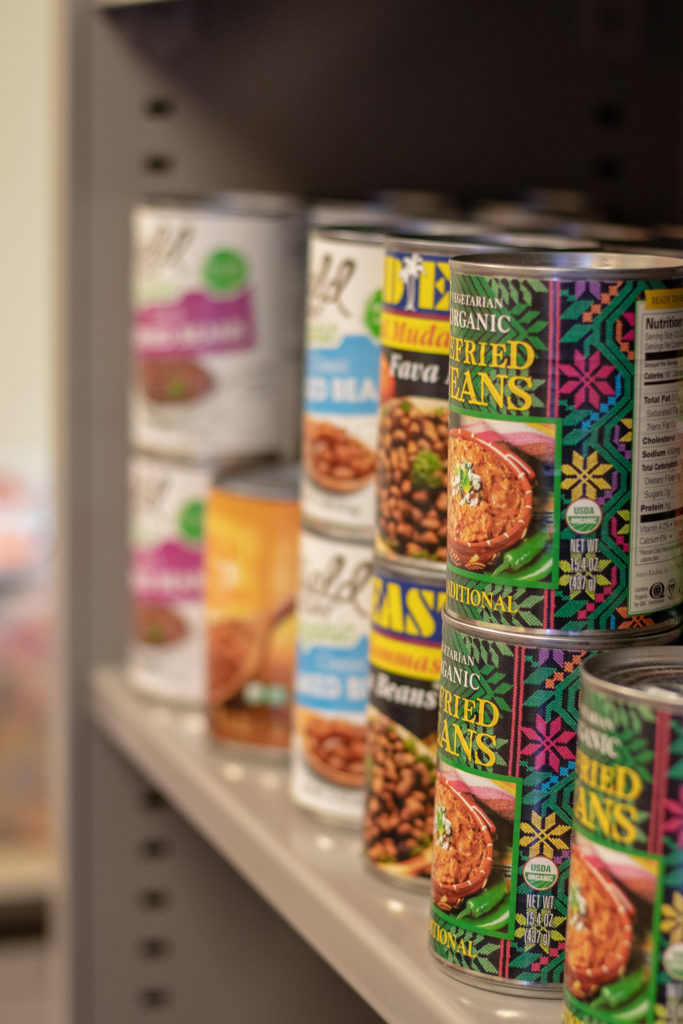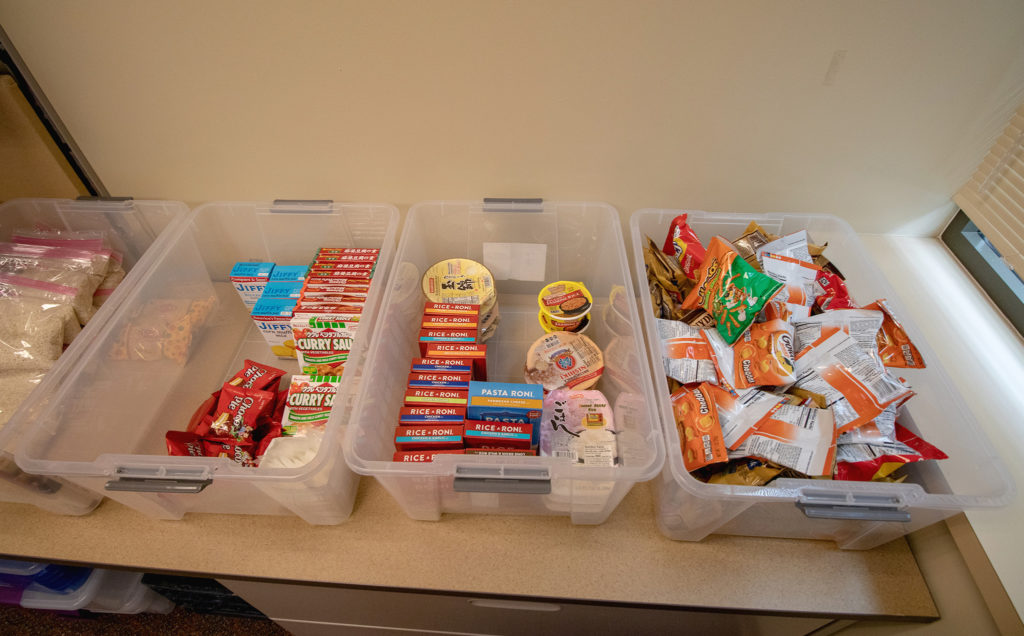A Problem Hidden in Plain Sight: How the Seattle U Food Pantry is Helping Fight Hunger on Campus
According to a 2018 study conducted by the Wisconsin HOPE Lab, 36% of university students at 66 surveyed universities and colleges had experienced food insecurity in the previous 30 days—the study further concluded that an estimated 42% of college students experience it. It defines food insecurity as, “the disruption of food intake or eating patterns because of lack of money or other resources.”
The Office of Multicultural Affairs (OMA) created the Food Security Initiatives at Seattle U to help combat and empower students who are facing hunger and are not receiving enough resources. OMA partnered with the Gender Justice Center (GJC) who spearheaded the programs toward food security and justice for students.

The pantry is an amazing place to pick up canned and non-perishable products for students facing hunger and food insecurity.
According to OMA’s website, the pantry, which opened this past January, “provides free, supplementary food to all those with a current SU ID.” The pantry is located in OMA’s office and is open three times a week.
“If I had to ballpark, I would guess that we see maybe 30 to 40 people a week in the pantry,” OMA Graduate Coordinator for the Food Pantry Tegan Mitchell said.
Highlighting the need for resources and increased awareness surrounding the issue of food insecurity on Seattle U’s campus, the students responsible for the creation of the food pantry have worked hard to establish programs that provide for students facing food insecurity.
One of these students, Anab Nur, who is the President of the GJC at Seattle U, said the GJC realized the issue of food insecurity was being neglected on campus despite its highly negative impacts.
“We wanted to meet the needs of the students who are most marginalized,” Nur said.“Then we thought about those students and what they needed the most, and one of the things we knew was needed was food, because some people are hungry and don’t have enough money to buy every meal.”
As a result of their efforts, the GJC was able to collaborate with Chartwells, Student Development, and the Office of Multicultural Affairs to create the Food Security Initiatives, which include the food pantry and other programs that help fill in the gaps where students are experiencing financial instability.
The importance of these resources is emphasized when looking at the additional medical and academic barriers that can arise for students who are experiencing food insecurity. According to the Center for Disease Control, two effects of hunger include the inability to focus and excessive absences due to illness, which can make it difficult for students to thrive in their academic career to the best of their ability.
“It’s not because they’re not capable or brilliant, but because that is the way that our financial system is set up.”
There is a common misconception that students attending a private or prestigious university are affluent enough to not have to experience hunger and its effects, However, food insecurity affects many students at Seattle U in several different ways.
“Students are experiencing hunger for a myriad of reasons,” Mitchell said.
Citing the rising cost of tuition, housing, transportation, insurance, and medical care as some of the reasons, she went on to explain how the Food Security Initiatives find it imperative to break the stigma surrounding food insecurity.
“It’s not because they’re not capable or brilliant, but because that is the way that our financial system is set up,” Mitchell said. “The reasons why people are hungry is because of structural barriers. No student is deficient, and no student is incapable of feeding themselves. It’s structure, it’s institutions, it’s higher-ed in general, that are not meeting the needs of students, and not the student who can’t meet their own needs.”
To meet the needs of the students, the food pantry provides access to a variety of food items that can be picked up in the OMA Office from 12 p.m. to 2 p.m. on Mondays, 6 p.m. to 9 p.m. on Wednesdays, and 8 a.m. to 11 a.m. on Fridays. Mitchell mentioned that it works in accommodating different schedules of students.
The food pantry also takes into consideration the fact that students who are experiencing hunger might have dietary restrictions, needs, and preferences for certain types of food, so they ask for and provide a diverse range of offerings in order to be mindful of the community being served.
The dining card program is another one of the programs housed under the Food Security Initiatives. Supplementing the food pantry, the program allows anyone with a student ID to get a dining card preloaded with $10, $25, $50, $100, or $200, and can be accessed by an individual every two weeks.
Comparing the Seattle U food pantry to the University of Washington’s (UW) food pantry to get ideas as to how it could be improved, their emphasis on collaboration stands out.
The UW food pantry is under the ‘Any Hungry Husky’ Program.

Ramen noodles, cereal boxes and various spices are all accessible for students in need at the food pantry.
“This initiative encompasses a lot of our campus partnerships,” Christina Sun, UW Pantry Coordinator and Public Health grad student said. These partnerships include a voucher program with the student-run food co-op, food deliveries from the UW Farm, donations from eateries on campus, and food exchanges with the University District Food Bank.
Another aspect of the UW food pantry that stood out was the physical space.
“I think we’re able to expand our reach, just because we have so much space. It’s inviting, you know. I want to make it like a second home for a lot of our shoppers,” Sun said.
Program Management and Communication Intern Jade Chan wanted to highlight the success these aspects of the food pantry have had within the UW community.
“We have served over 1,000 students since we opened our permanent location on Nov. 1 at Poplar Hall,” Chan said.
As the Seattle U food pantry continues to grow, adopting these aspects from the UW food pantry could help increase the reach and effectiveness of this resource for students experiencing food insecurity on Seattle U’s campus.
In addition to implementing ideas from other food pantries, there is still work to be done by the Seattle U food to get additional support and coverage.
“The university has a lot of programs to fund, but this is a fundamental issue, so it should be getting more coverage,” Mitchell said. “In addition, the food pantry is still new, so it could use some more coverage, widespread coverage, on our campus so everyone knows it is a resource.”
Another factor that should be taken into consideration is the social stigma that students feel from experiencing hunger on Seattle U’s campus. Interestingly enough, a small food pantry run out of the GJC that students can access anonymously runs out of food consistently, revealing that the stigmatization surrounding food insecurity is still present on our campus.
At the end of the day however, the food pantry is a starting point for meeting the needs of students on Seattle U’s campus, and it’s not going anywhere.
“Our goal is to be a stepping stone for these students,” Mitchell said. “Until eventually they do not need these resources anymore because they won’t have these barriers that are causing them to experience food insecurity.”
The editor may be reached at
[email protected]



